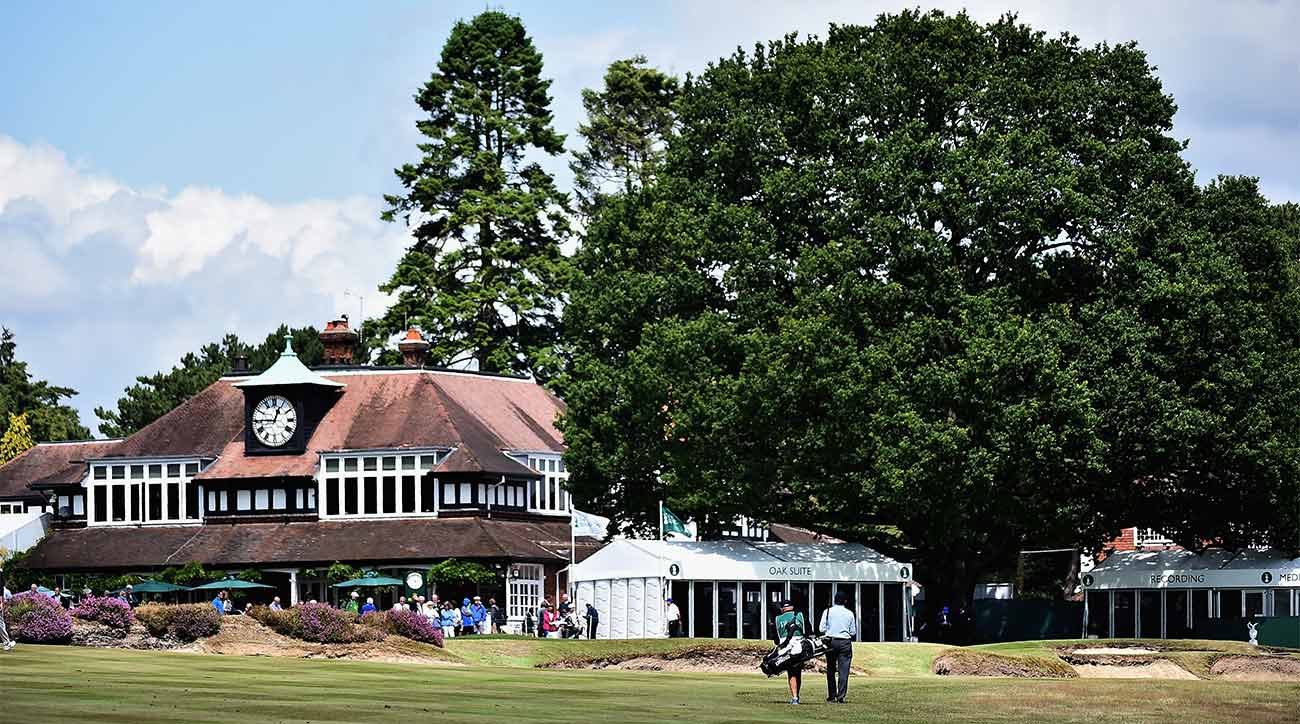The United Kingdom’s best-kept secret? Its ties to Augusta National
- Share on Facebook
- Share on Twitter
- Share by Email

Before Bobby Jones partnered with Alister MacKenzie to design Augusta National, he fell in love with Sunningdale Golf Club (above) across the Atlantic.
Kevin Diss Photography
We hate to break the bad news, but odds are you’ll never get the chance to drive down Magnolia Lane; you’ll never know what it feels like to stand in the fairway on Azalea, weighing your options of taking on Rae’s Creek and going for the green in two; and you’ll never have the opportunity to sip on a chilled beverage as you relax in one of the chairs set around the veranda of Augusta National’s iconic clubhouse. The house that Bobby Jones built is just too exclusive. There’s private. And then there’s Augusta National private.
As it turns out, experiencing the next best thing is no less memorable. It simply requires a flight across the Atlantic.
More than half a decade before Jones partnered with Alister MacKenzie to design Augusta National, the game’s most celebrated amateur champion traveled to England, where he qualified for the 1926 Open Championship by playing two competitive rounds on the Old Course at Sunningdale Golf Club (and setting a then-course record in the process).
“I wish I could take this course home with me,” he said afterward.
In some ways, Jones did. The layout that he and MacKenzie conceived in the early 1930s bears some resemblance to the 6,660 yards of heathland golf that Herbert Fowler masterfully routed through the hardwood forest of Surrey County just southwest of London. The Old Course opened for play 124 years ago, and yet it’s routed across the land so brilliantly that it looks as old as the hills over which it trundles. That Augusta National weaves its way over and around the hillsides of northern Georgia in a similar fashion is no surprise, not when you consider how much Jones was enchanted by Sunningdale.
In fact, Sunningdale’s second course, the New, is no less spellbinding. Bill Hogan, the business development manager of Premier Golf, a private travel operator that specializes in bespoke golf journeys, can attest to that. Hogan has had the good fortune of playing both multiple times.
“Traversing the rolling hills of Ascot with the heather in bloom and the huge oak trees surrounding the fairways,” he says of Sunningdale’s duo, “they’re both as pretty a Heathland golf course as you’ll ever see. You know you’re walking on hallowed grounds.”

In Hogan’s estimation, the experience that comes after completing 18 holes at Sunningdale is no less extraordinary. Spending a languid summer day on the deck at Sunningdale, either after a round or in-between rounds played on both courses — should you feel that ambitious — is not unlike the experience that members and their guests at Augusta National enjoy around their own veranda, which is why some have opined that Jones’ experiences at Sunningdale inspired him to convert the former indigo plantation house into Augusta National’s clubhouse.
“If you’ve done it once or 100 times, it never gets old,” Hogan says of the experiences relaxing on that deck. “It’s just one of those magical settings in golf.”
As it turns out, there are magical experiences to be had playing all of Surrey’s heathland courses. So named for the region’s indigenous terrain — the Brits describe the heath as “an area of open uncultivated land, with characteristic vegetation of heather, gorse and coarse grasses” — these historic venues were established during the early 20th century, when golfers and course designers were looking for new places to play and, as a result, turned their gaze inland, away from the established links.
Ironically, how they play is not much different than those seaside courses, given that they’re routed across sand-based terrain that plays firm and fast. Teddy Lynn, who grew up playing golf in the region, knows this as well as anyone. In fact, he became so enamored by the golf courses of this style that when he created his own golf footwear company a little more than a year ago, he used a cross-section of the heather plant as the shoes’ tread pattern and named the brand Heathlander.
“These courses are examples of Old World golf that didn’t move and smooth a lot of land, so there are bumps and contours — there’s a ground game involved,” he says. “It requires tons of imagination and that makes them really appealing.”

First-timers to Surrey will soon discover that most of the courses are at least partially defined by broad swaths of heather lining many of the fairways. More specifically, they’ll learn of the vegetation’s deceptive qualities. From afar, these patches of vegetation only seem unassuming, especially when they’re not in bloom.
“It looks quite benign, but it’s anything but,” says Gordon Dalgleish, founding director at PerryGolf, a travel company that specializes in international golf tours. “It can grab a golf club and turn it over. And it steals golf balls, but very attractively.”
Adds Lynn, “It’s better looked at than played out of.”
To the uninitiated, the heather may be a sneaky defense on these courses, but there are other striking features that add challenge. At The Berkshire Golf Club, for example, the Red Course’s short par-4 12th hole entices players to pull drivers from their bags, but miss your intended line, and a difficult side-hill lie (possibly compounded by thick heather) will make you yearn for a mulligan. Therein lies the difficulty in these courses. Their architects understood how to leverage the site’s natural topography to create a notable test without stretching the courses to 7,000 yards or more.
“Many of the great heathland courses are not long,” Lynn says. “They’re 5,800 to 6,200 yards. But given the weather and the conditions, you still might hit every club in your bag.”
While the region’s most famous heathland golf clubs — Sunningdale, The Berkshire, Walton Heath, Swinley Forest, St. George’s Hill — are all technically private, they’re not inaccessible to outside play. In fact, as Lynn explains, so long as you go through the proper channels of contacting the club’s secretary to arrange a tee time during the limited windows of availability to non-members, you’ll be welcomed to each club almost as if you are a member.
“It used to be that the members avoided visitor days,” he says. “But now you’ll find the members are at lunch, holding court and telling you about their place. They’re really delighted that people are appreciating what they have and they’re excited to show off their courses.”
Shaun Tolson is a freelance writer based in Rhode Island. When it comes to golf, he covers everything from architecture, course reviews, and travel, to equipment, gadgets and gear, and feature profiles. As a lifestyle writer, his expertise is rooted in the finer things in life — wine and spirits, luxury automobiles, private aviation, hotels & resorts, fine dining, and more.
Latest In Travel

Golf.com Contributor

